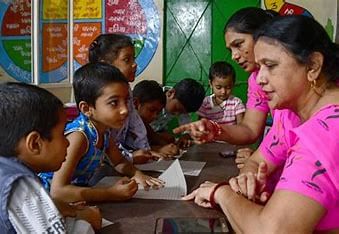UPSC Daily Current Affairs- 21st April 2024 | Current Affairs & Hindu Analysis: Daily, Weekly & Monthly PDF Download
GS-I
Panhala Fort
Subject: History
Source: The Hindu

Why in News?
The Archaeological Survey of India (ASI), Mumbai Circle celebrated World Heritage Day on at Panhala Fort.
- Location: Situated in Maharashtra, Panhala Fort holds significant historical importance in the state.
- Historical Significance: Locally known as the abode of serpents and linked with the sage Parashar. It strategically lies near trade routes connecting the Sahyadri mountains, the Deccan plateau, and the Konkan coast, attracting various dynasties over time.
- Antiquity: Tracing back to the rule of Bhoja from the Shilahara dynasty in the 11th century CE.
Structural Features
- Nayikinicha Sajja: A three-storied tower, also known as the dancing girl's tower, constructed during the reign of Ibrahim Adil Shah II in 1591 C.E. The tower boasts intricate stucco moldings in its interior.
- Ambarkhana: Central structure comprising the Ganga, Yamuna, and Saraswati buildings, each with sixteen bays featuring individual flat vaults with holes on top.
- Dharma Kothi: Another granary positioned west of Ambarkhana, accessible through a single staircase leading to its top.
- Sajja Kothi: A double-storied building with an upper gallery occupying a prominent hilltop position, dating back to the reign of Bijapur King Ibrahim Adilshah in 1607-08 CE.
World Heritage Day
Subject: Art and CultureSource: Hindustan Times

Why in News?
World Heritage Day, also known as the International Day for Monuments, is celebrated on April 18 annually.
- The day aims to enhance awareness about monuments and sites that are integral to our history and culture.
Background
- In 1982, the International Council on Monuments and Sites (ICOMOS) suggested observing World Heritage Day on April 18. The proposal was endorsed at UNESCO's General Conference the subsequent year.
Theme of 2024
- The theme for this year's World Heritage Day is "Discover and experience diversity."
Significance
- World Heritage Day raises consciousness among local communities regarding the preservation of cultural heritage.
- It fosters the exchange of historical and traditional knowledge among individuals from diverse backgrounds and regions.
What is International Council on Monuments and Sites?
- ICOMOS, established in 1965 following the ratification of the Charter of Venice, is a non-governmental organization dedicated to advocating conservation principles and techniques.
- It furnishes the World Heritage Committee with evaluations of culturally significant properties proposed for inclusion on the World Heritage List, along with comparative analyses, technical aid, and assessments on the conservation status of listed properties.
GS-II
Centre Releases Curriculum Framework for Three to Six-year-olds
Subject: Polity and Governance
Source: The Hindu

Why in News?
For the first time, the Central government has introduced a curriculum to be taught to children aged three to six years.
Objective of Aadharshila
- The early childhood education curriculum aims to address foundational literacy and numeracy gaps that may occur in later school years.
Launch Details
- The Ministry of Women and Child Development (MWCD) has unveiled the National Curriculum for Early Childhood Care and Education 2024 named 'Aadharshila' in alignment with the National Education Policy 2020 and the National Curriculum Framework.
About Aadharshila
- Aadharshila, meaning 'foundation stone,' is a comprehensive 48-week curriculum tailored for children aged three to six in anganwadis.
Key Features of Aadharshila's Curriculum
- Curriculum Structure: The curriculum is structured on a weekly basis, spanning 48 weeks over three years, catering to children attending anganwadis.
- Initiation Phase: The curriculum commences with a four-week initiation period, focusing on academic activities to assist children in transitioning from home to the anganwadi center through engaging and playful activities.
- Exploration Phase: Following the initiation, 36 weeks are dedicated to exploration, free play, conversation, creation, and appreciation, involving activities like storytelling, singing, art, and craft with themes centering on conflict resolution, responsibility, and cooperation.
- Learning Objectives: Children are exposed to various concepts including colors, shapes, numbers, body parts, family and friends, listening and responding to instructions, basic counting, and themes like seasons, festivals, and food.
Anganwadi Services
- Anganwadi services in India are a part of the Integrated Child Development Services (ICDS) scheme, initiated on 2nd October 1975.
- The primary goal of the Anganwadi program is to enhance the nutritional and health status of children aged 0-6 years, laying the groundwork for their proper psychological, physical, and social development, and reducing mortality, morbidity, malnutrition, and school dropout rates.
Conclusion
- The introduction of 'Aadharshila' signifies a significant advancement in early childhood education, aiming to bridge foundational gaps. To optimize its impact, continuous monitoring, teacher training, and community engagement are vital.
Key facts about indelible ink used in elections
Subject: Polity and Governance
Source: Money Control

Why in News?
As the Lok Sabha elections is round the corner, the classic symbol of Indian polls is visible everywhere – a index finger marked by a purple-black indelible ink.
About Indelible Ink:
- It contains silver nitrate. It is a colourless compound which becomes visible when exposed to ultraviolet light, including sunlight.
- The higher silver nitrate’s concentration, the higher will be the ink’s quality.
- For up to 72 hours after application it can remain resistant to soap, liquids, home-cleansing, detergents, etc.
- This water-based ink also contains a solvent like alcohol to allow its faster drying.
- The precise protocol for making this ink including its chemical composition and the quantity of each constituent is, however, not known to many people.
Manufacture and Export:
- The indelible ink was first manufactured at the Election Commission of India’s request by the government’s Council of Scientific & Industrial Research (CSIR).
- Mysore Paints & Varnish Ltd. has been licensed to manufacture the ink and has been in the business since 1962.
- It is exported to more than 25 countries that include Canada, Ghana, Nigeria, Mongolia, Malaysia, Nepal, South Africa and the Maldives.
Legal Mention:
- The Representation of the People Act (RoPA) of 1951 mentions the ink.
- Section 61 states that rules may be made under the Act “for the marking with indelible ink of the thumb or any other finger of every elector who applies for a ballot paper or ballot papers for the purpose of voting at a polling station before delivery of such paper or papers to him.”
GS-III
Vasuki Indicus: 50ft Snake Fossil Found in Gujarat
Subject: Science and TechnologySource: Times of India

Why in News?
A fossil discovered in Gujarat's Kutch in 2005, initially thought to be a giant crocodile, has now been identified as one of the largest snakes 'Vasuki Indicus' known to have existed on Earth.
About Vasuki Indicus
- The scientists at IIT Roorkee named the fossil species 'Vasuki Indicus'.
- The name 'Vasuki' is derived from the mythological snake often portrayed encircling the neck of the Hindu deity Shiva.
Physical characteristics of Vasuki
- It is estimated to be between 11m (36ft) and 15m (49.22ft) in length.
- Belonging to the extinct Madtsoiidae snake family, its size potentially exceeded that of the extinct Titanoboa, with Titanoboa and Python being its closest relatives.
- Its large size suggests it was a slow-moving, ambush predator, similar to an anaconda.
- Similar to modern pythons and anacondas, Vasuki Indicus likely used constriction (suffocation) as its primary method of capturing prey.
Age and Geological Context
- Unearthed from the Panandhro Lignite Mine in Kutch, the fossil dates back to the Middle Eocene period, approximately 47 million years ago.
- Examination of the well-preserved vertebrae indicates the snake existed during a warm geological period with average temperatures around 28°C.
- 'Vasuki' is thought to represent an extinct lineage originating in India, spreading from the subcontinent to North Africa through southern Eurasia due to the India-Asia collision.
- Vasuki thrived during a time when Africa, India, and South America were joined as a single landmass.
Significance for India
- This finding highlights India's diverse biodiversity.
- It has the potential to provide valuable insights into evolution, continental movements, and India's significant role in the development of various species, particularly reptiles.
Global Financial Stability Report
Subject: Economy
Source: First Post

Why in News?
The International Monetary Fund (IMF) released the latest Global Financial Stability Report 2024 (with the central theme - ‘The Last Mile: Financial Vulnerabilities and Risks’).
- Definition: The Global Financial Stability Report (GFSR) is a biannual publication by the International Monetary Fund (IMF) that evaluates the stability of worldwide financial markets and emerging-market financing.
- Release Schedule: It is published twice a year, in April and October, focusing on current market conditions and identifying systemic issues that could jeopardize financial stability and sustained market access by borrowers in emerging markets.
- Content Focus: The report delves into the financial implications of economic imbalances highlighted in the IMF's World Economic Outlook.
IMF's Concerns Regarding Inflation
- Rising Enthusiasm: The IMF has raised concerns about investors' growing optimism that the battle against high inflation is nearing an end.
- Premature Enthusiasm: The IMF cautions that investor optimism regarding slowing inflation and potential interest rate cuts by central banks may be premature.
- Geopolitical Risks: The IMF highlights geopolitical risks such as conflicts in West Asia and Ukraine that could disrupt aggregate supply chains and lead to increased prices.
Implications for India
- Fund Flows: India has been a significant beneficiary of fund inflows due to positive sentiments around central banks lowering interest rates.
- Potential Risks: If western central banks indicate a prolonged period of high interest rates, it could prompt investors to withdraw funds from emerging markets like India, exerting pressure on their currencies.
- Rupee Depreciation: The Indian rupee has already experienced depreciation, hitting a new low against the US dollar, potentially impacting the country's financial system.
Concerns About the Private Credit Market
- Unregulated Market Growth: The IMF has expressed apprehension about the expansion of the unregulated private credit market, where non-bank financial entities lend to corporate borrowers.
- Financial Soundness: There are concerns about the financial health of borrowers in this market, with many lacking earnings that cover their interest costs.
- Indian Scenario: India has witnessed the emergence of a small private credit market through Alternative Investment Funds (AIFs) that cater to high-risk borrowers not served by traditional banking institutions.
- Regulatory Oversight: Both the RBI and SEBI have been monitoring this trend closely and enhancing scrutiny over these funds to ensure financial stability.
Insurance Sector in India
Subject: Economy
Source: Times Now

Why in News?
The Insurance Regulatory and Development Authority of India (IRDAI) has removed the age limit for purchasing health insurance policies, with effect from April 1.
Insurance Sector in India:
- India’s Insurance industry is one of the premium sectors experiencing upward growth.
- India is the fifth largest life insurance market in the world's emerging insurance markets, growing at a rate of 32-34% each year.
- The insurance industry of India has 57 insurance companies - 24 are in the life insurance business, while 34 are non-life insurers.
- Among the life insurers, Life Insurance Corporation (LIC) is the sole public sector company. There are six public sector insurers in the non-life insurance segment.
- Regulation:
- The Insurance Regulatory and Development Authority of India (IRDAI) is the regulatory body that oversees and regulates the insurance sector in India.
- It ensures that insurance companies comply with regulations, protect policyholders' interests, and maintain the stability of the insurance market.
Challenges of Insurance Sector in India:
- Low Insurance Penetration and Awareness: Despite the increasing awareness about financial planning, insurance penetration remains low in India. The insurance penetration is only 4 per cent. Many people are still unaware of the importance of insurance and its benefits, leading to a large uninsured population.
- Distribution Challenges: Limited access to insurance products and services in rural and remote areas due to inadequate infrastructure and distribution networks hinders the expansion of the insurance market.
- Regulatory Constraints: While regulations are essential for ensuring consumer protection and market stability, stringent regulatory requirements can sometimes be a barrier for innovation and growth in the insurance sector.
- Fraud and Mis-selling: The insurance sector grapples with issues related to fraud and mis-selling of insurance products. Unscrupulous practices by some agents and intermediaries can erode consumer trust and confidence in insurance products.
- Technological Adaptation: Adopting new technologies and digital platforms to enhance customer experience, streamline operations, and offer innovative products is a challenge for traditional insurance companies.
- Underwriting Risks: Assessing and pricing risks accurately is crucial for the sustainability of insurance companies. Inadequate data and analytics capabilities can lead to mispricing of risks, impacting profitability.
- Competitive Landscape: With the entry of new players, both domestic and foreign, the competitive landscape in the insurance sector has become intense. Established players need to differentiate their offerings and adapt to changing market dynamics to maintain their market share.
- Healthcare Inflation: Rising healthcare costs and increasing prevalence of lifestyle-related diseases pose challenges for health insurance providers in managing claims and maintaining profitability.
- Macro-economic Factors: Economic downturns, inflation, and fluctuations in interest rates can impact investment returns and profitability of insurance companies, affecting their ability to meet policyholder obligations.
- Product Innovation and Customization: Developing customized and innovative insurance products that cater to the diverse needs of consumers while ensuring affordability and profitability is a continuous challenge for insurers.
FDI in Insurance Sector:
- The insurance sector has received close to Rs 54,000 crore as foreign direct investment (FDI) in the last 9 years.
- The government increased the permissible FDI limit from 26 per cent in 2014 to 49 per cent in 2015 and then to 74 per cent in 2021.
|
55 videos|5389 docs|1141 tests
|
FAQs on UPSC Daily Current Affairs- 21st April 2024 - Current Affairs & Hindu Analysis: Daily, Weekly & Monthly
| 1. What is the significance of Panhala Fort in Indian history? |  |
| 2. What is the theme of World Heritage Day and why is it celebrated? |  |
| 3. What are the key highlights of the Centre's released Curriculum Framework for Three to Six-year-olds? |  |
| 4. How is indelible ink used in elections and what are its key features? |  |
| 5. What are the key takeaways from the Global Financial Stability Report? |  |





















